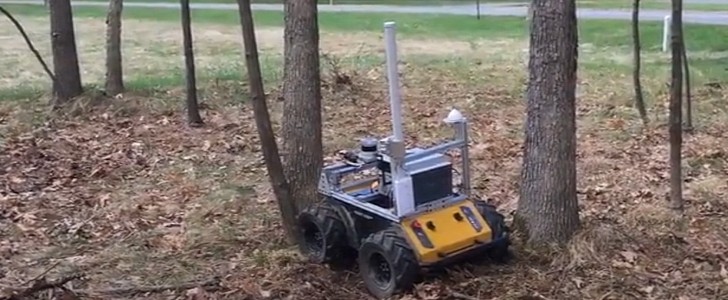It may look like a remote controlled toy, but this apparently plain-looking vehicle is actually a prototype for what could be the U.S. Army’s next robotic “ATV” specifically designed to meet off-road challenges.
It was only a year ago that the U.S. Army launched a groundbreaking program meant to advance the development of an all-new off-road autonomous vehicle. Known as the Scalable, Adaptive and Resilient Autonomy (SARA) program, and funded by the Combat Capabilities Development Command’s (CCDC) Army Research Laboratory, this research had a clear objective.
The end goal was to bring forth a robotic vehicle that could operate in an unfamiliar environment, on difficult terrain, without having access to data similar to a map, or the ability to communicate.
GE Research was one of the 8 partners that were selected for SARA, most of them from the academic sector. Less than 1 year later, it’s proud to announce that its robotic “ATVer” has successfully passed what could be called a road test.
Led by Senior Scientist Shiraj Sen, the General Electric Research Robotics Team has developed and demonstrated an autonomous ground vehicle that can operate effectively in a complex off-road environment.
What makes this robotic ATVer unique is that it’s risk-aware, meaning that it can recognize and assess risks when operating in uncertain, unfamiliar conditions. This is possible thanks to the integration of GE’s Humble AI technology. With the help of this algorithmic mechanism, the vehicle can process the information it gets from its “eyes” – LIDAR and other visual technologies – and assess what the next step should be, for example in the case of obstacles.
The idea was to make this robotic ATV capable of operating in complex battlefield environments for which there would be no available maps. This could be a wooded area with typical off-road challenging factors, uncertain conditions and numerous natural obstacles. The future autonomous ATV should be able to avoid obstacles, make decisions quickly and operate safely, so that it can complete its mission even in the toughest combat environment possible.
GE’s recent demonstration proved that such a vehicle could soon become a reality. Tested at the company’s research campus in Niskayuna, New York, the robotic ATV made its way through the heavily wooded areas, based only on its AI algorithm. An important milestone, this breakthrough takes the Army one step closer to high-performance off-road autonomous vehicles.
The end goal was to bring forth a robotic vehicle that could operate in an unfamiliar environment, on difficult terrain, without having access to data similar to a map, or the ability to communicate.
GE Research was one of the 8 partners that were selected for SARA, most of them from the academic sector. Less than 1 year later, it’s proud to announce that its robotic “ATVer” has successfully passed what could be called a road test.
Led by Senior Scientist Shiraj Sen, the General Electric Research Robotics Team has developed and demonstrated an autonomous ground vehicle that can operate effectively in a complex off-road environment.
What makes this robotic ATVer unique is that it’s risk-aware, meaning that it can recognize and assess risks when operating in uncertain, unfamiliar conditions. This is possible thanks to the integration of GE’s Humble AI technology. With the help of this algorithmic mechanism, the vehicle can process the information it gets from its “eyes” – LIDAR and other visual technologies – and assess what the next step should be, for example in the case of obstacles.
The idea was to make this robotic ATV capable of operating in complex battlefield environments for which there would be no available maps. This could be a wooded area with typical off-road challenging factors, uncertain conditions and numerous natural obstacles. The future autonomous ATV should be able to avoid obstacles, make decisions quickly and operate safely, so that it can complete its mission even in the toughest combat environment possible.
GE’s recent demonstration proved that such a vehicle could soon become a reality. Tested at the company’s research campus in Niskayuna, New York, the robotic ATV made its way through the heavily wooded areas, based only on its AI algorithm. An important milestone, this breakthrough takes the Army one step closer to high-performance off-road autonomous vehicles.








